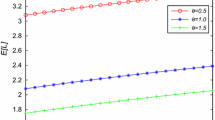Abstract
We study a BMAP/>SM/1 queue with batch Markov arrival process input and semi‐Markov service. Service times may depend on arrival phase states, that is, there are many types of arrivals which have different service time distributions. The service process is a heterogeneous Markov renewal process, and so our model necessarily includes known models. At first, we consider the first passage time from level {κ+1} (the set of the states that the number of customers in the system is κ+1) to level {κ} when a batch arrival occurs at time 0 and then a customer service included in that batch simultaneously starts. The service descipline is considered as a LIFO (Last‐In First‐Out) with preemption. This discipline has the fundamental role for the analysis of the first passage time. Using this first passage time distribution, the busy period length distribution can be obtained. The busy period remains unaltered in any service disciplines if they are work‐conserving. Next, we analyze the stationary workload distribution (the stationary virtual waiting time distribution). The workload as well as the busy period remain unaltered in any service disciplines if they are work‐conserving. Based on this fact, we derive the Laplace–Stieltjes transform for the stationary distribution of the actual waiting time under a FIFO discipline. In addition, we refer to the Laplace–Stieltjes transforms for the distributions of the actual waiting times of the individual types of customers. Using the relationship between the stationary waiting time distribution and the stationary distribution of the number of customers in the system at departure epochs, we derive the generating function for the stationary joint distribution of the numbers of different types of customers at departures.
Similar content being viewed by others
References
S. Asmussen and D. Perry, On cycle maxima, first passage problems and extreme value theory of queues, Stochastic Models 8 (1992) 421-458. F.Machihara / A BMAP=SM=1 queue 291
D.M. Lucantoni, The BMAP=G=1 queue: A tutorial, in: Models and Techniques for Performance Evaluation of Computer and Communication Systems, ed. L. Donatiello and R. Nelson (Springer, Berlin, 1993).
D.M. Lucantoni, K.S. Meier-Hellstern and M.F. Neuts, A single server queue with server vacations and a class of nonrenewal arrival processes, J. Appl. Probab. 22 (1990) 676-170.
D.M. Lucantoni and M.F. Neuts, Simpler proofs of some properties of the fundamental period of the MAP=G=1 queue, J. Appl. Probab. 31 (1994) 235-241.
D.M. Lucantoni and M.F. Neuts, Some steady-state distributions for the MAP=SM=1 queue, Stochastic Models 10 (1994) 575-598.
F. Machihara, Completion time of service unit interrupted by PH-Markov renewal customers and its application, in: Proc.of the 12th Internat.Teletraffic Congress, Torino (1988) 5.4b5.1-5.8.
F. Machihara, A new approach to the fundamental period of a queue with phase-type Markov renewal arrivals, Stochastic Models 6 (1990) 551-560.
F. Machihara, On the queue with PH-Markov renewal preemptions, J. Oper. Res. Soc. Japan 36 (1993) 13-28.
F. Machihara, A G=SM=1 queue with vacations dependent on service times, Stochastic Models 11 (1995) 671-691.
M. Miyazawa, Rate conservation laws; a survey, Queueing Systems 15 (1994) 1-58.
M. Miyazawa, Decomposition formulas for single server queues with vacations: A unified approach by the rate conservation law, Stochastic Models 10 (1994) 389-413.
M.F. Neuts, Some explicit formulas for the steady-state behavior of the queue with semi-Markovian service times, Adv. in Appl. Probab. 9 (1977) 141-157.
M.F. Neuts, Matrix-geometric Solutions in Stochastic Models: An Algorithmic Approach (Johns Hopkins Univ. Press, Baltimore, MD, 1981).
M.F. Neuts, Structured Stochastic Matrices of M=G=1 Type and Their Applications (Marcel Dekker, New York/Basel, 1989).
M.F. Neuts, The fundamental period of the queue with Markov modulated arrivals, in: Probability, Statistics and Mathematics: Papers in Honor of Professor Samuel Karlin (Academic Press, New York, 1989).
B. Sengupta, The semi-Markovian queue: Theory and applications, Stochastic Models 6 (1990) 383-413.
T. Takine and T. Hasegawa, The workload in the MAP=G=1 queue with state-dependent services: Its application to a queue with preemptive resume priority, Stochastic Models 10 (1994) 183-204.
H. Yamada and F. Machihara, Performance analysis of a statistical multiplexer with control on input and/or service process, Performance Evaluation 14 (1992) 21-41.
Y. Zhu and N.U. Prabhu, Markov modulated PH=G=1 queueing systems, Queueing Systems 9 (1991) 313-322.
Author information
Authors and Affiliations
Rights and permissions
About this article
Cite this article
Machihara, F. A BMAP/SM/1 queue with service times depending on the arrival process. Queueing Systems 33, 277–291 (1999). https://doi.org/10.1023/A:1019132314203
Issue Date:
DOI: https://doi.org/10.1023/A:1019132314203




